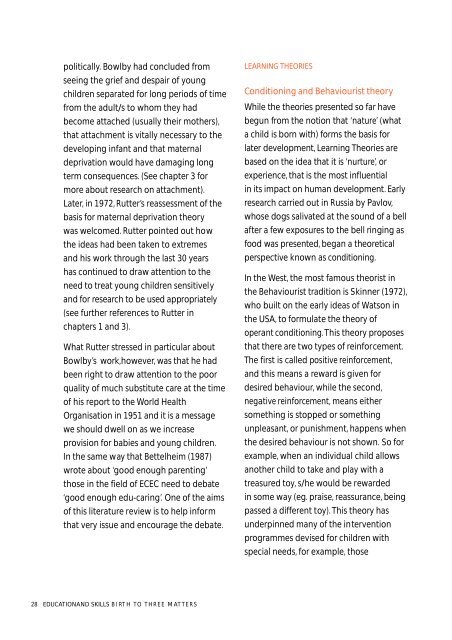Birth to three matters - Communities and Local Government
Birth to three matters - Communities and Local Government
Birth to three matters - Communities and Local Government
Create successful ePaper yourself
Turn your PDF publications into a flip-book with our unique Google optimized e-Paper software.
politically. Bowlby had concluded fromseeing the grief <strong>and</strong> despair of youngchildren separated for long periods of timefrom the adult/s <strong>to</strong> whom they hadbecome attached (usually their mothers),that attachment is vitally necessary <strong>to</strong> thedeveloping infant <strong>and</strong> that maternaldeprivation would have damaging longterm consequences. (See chapter 3 formore about research on attachment).Later, in 1972, Rutter’s reassessment of thebasis for maternal deprivation theorywas welcomed. Rutter pointed out howthe ideas had been taken <strong>to</strong> extremes<strong>and</strong> his work through the last 30 yearshas continued <strong>to</strong> draw attention <strong>to</strong> theneed <strong>to</strong> treat young children sensitively<strong>and</strong> for re s e a rch <strong>to</strong> be used appro p ri ate ly(see further references <strong>to</strong> Rutter inchapters 1 <strong>and</strong> 3).What Rutter stressed in particular aboutBowlby’s work,however, was that he hadbeen right <strong>to</strong> draw attention <strong>to</strong> the poorquality of much substitute care at the timeof his report <strong>to</strong> the World HealthOrganisation in 1951 <strong>and</strong> it is a messagewe should dwell on as we increaseprovision for babies <strong>and</strong> young children.In the same way that Bettelheim (1987)wrote about ‘good enough parenting’those in the field of ECEC need <strong>to</strong> debate‘good enough edu-caring’. One of the aimsof this literature review is <strong>to</strong> help informthat very issue <strong>and</strong> encourage the debate.LEARNING THEORIESConditioning <strong>and</strong> Behaviourist theoryWhile the theories pre s e nted so far havebegun from the notion that ‘n a t u re’ ( w h ata child is bo rn with) fo rms the basis fo rl ater deve l o p m e nt, Le a rning Th e o ries arebased on the idea that it is ‘n u rt u re’, o rex pe ri e n ce, t h at is the most influentialin its impact on human deve l o p m e nt. Ea rlyre s e a rch ca rried out in Russia by Pav l ov,whose dogs salivated at the sound of a be l la fter a few ex po s u res <strong>to</strong> the bell ringing asfood was pre s e nte d, began a theore t i ca lpe r s pe ct i ve kn own as co n d i t i o n i n g.In the West, the most famous theorist inthe Behaviourist tradition is Skinner (1972),who built on the early ideas of Watson inthe USA, <strong>to</strong> formulate the theory ofoperant conditioning.This theory proposesthat there are two types of reinforcement.The first is called positive reinforcement,<strong>and</strong> this means a reward is given fordesired behaviour, while the second,negative reinforcement, means eithersomething is s<strong>to</strong>pped or somethingunpleasant, or punishment, happens whenthe desired behaviour is not shown. So forexample, when an individual child allowsanother child <strong>to</strong> take <strong>and</strong> play with atreasured <strong>to</strong>y, s/he would be rewardedin some way (eg. praise, reassurance, beingpassed a different <strong>to</strong>y). This theory hasunderpinned many of the interventionprogrammes devised for children withspecial needs, for example, those28 EDUCATIONAND SKILLS B I RT H T O T H R E E M AT T E R S
















